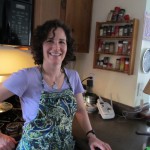Ask + Listen + Borrow = a Formula for Finding Vibrant Health
Fining Your Own Path
By JiJi Russell
I want to offer you a “story starter.” The idea comes from kindergarten classrooms, where teachers ask newly reading and writing students to continue a given sentence or fragment. The starter might be something like, “When I am really hungry . . . .” The student creates the rest of the story, sometimes drawing an illustration to go along with it. The starter provides a gateway into creative thinking and writing.
The story starter I offer you should serve as an inquiry for you, not an intellectual or mechanical exercise. It will require some thought, perhaps some dialogue with someone close to you—maybe some writing. Most of all it will require you to cultivate awareness of what you are doing to contribute to or detract from your overall health each day.
The Back Story
I recently aged into a new decade, while also working my first full year for American Public University System as the wellness coordinator serving more than 2,000 employees. My story of health and those of many people I have gotten to know at work have helped me recognize an old maxim: good health is a participatory process.
Sure, some people are born with a more robust “health account” than others, but taking time to discover and honor your own unique blueprint for achieving optimal health holds many rich rewards. Good health can offer you an enhanced ability to bring greater energy and positive contributions to your family and friends, your community, your work, and the causes you support.
After 12 years working in alternative health and wellness practices, I have observed that when people accept primary responsibility for finding their own source of health and vibrant energy, they tend to be more successful at fulfilling health-related goals. I’m not suggesting a completely “go it alone” strategy. Indeed, sometimes a veritable team of helpers is needed. For my part, I have leaned on the guidance and therapies of chiropractors; a health coach; an herbalist; spiritual teachers; physical therapists; an acupuncturist; my parents; my husband; and others. I also have learned by working with such a diverse group of people that what works for one person won’t necessarily work for another. This is why personal inquiry—your story starter—is so important.
It’s the Little Things
Sometimes health inquiry and discovery is a wonderful exploration; other times, particularly during health crises, it can be wrought with frustration and setbacks.
Personally, the last twelve months have been more challenging than any other year of my life. I have had to dig deep to cultivate practices and habits that are most supportive to recovering my energy, patience, and stamina. I’ve learned wonderful things along the way, and have come into contact with some extraordinary people through the work I do. I have learned that those who want to find true, deep health often have to work hard to bring it to the fore. They have to make lifestyle changes; they have to develop new habits; they sometimes have to let relationships go if they are not supporting their greatest health.
It is not one peak experience that establishes or reestablishes good health. It is what we do every day. It is the way we eat; they way we connect with others; the way we sleep; the way we approach our work. It’s all the little things that matter. All the little things can, and often do, lead to a large shift toward a higher plane of health and wellness. In my work, I often refer to a quote I once heard, one often linked to Zen Buddhism: “The way you do anything is the way you do everything.” Do you get up in the morning with a mere 20 minutes to shower, dress, eat, and prepare yourself for the day? Does the rest of your day reflect this truncated way of “doing”? This is but one example of how you might start thinking about your life’s details in order to reveal the larger story of your health and wellness. If you trust that you are the one who can best reveal your own path to vibrant health, start your story today (see sidebar).
Your Story Starts Here
Begin with a question: What is one thing I can do to improve my health? If this seems too vague or complex, you can simply frame the question around your energy level and focus on today: What is one thing I can do today to improve my energy level?
Ask yourself the question either mentally or aloud, and simply listen for a moment while you take a few deep breaths. You might jot down words or images that come to mind. After the first idea or ideas come forth, ask yourself the same question again. See what comes. You might discover repeated words or images from your first round, or something completely different. It’s all okay. Just “be with it” for a few deep breaths.
Once you find one or two words, images, or concepts that you can accept, create a positive statement for yourself that utilizes this information. Repeat this statement in the morning, afternoon, and evening every day until you feel you have integrated it into your life.
Need help? Put the question to your partner, your best friend, a trusted health provider. Or, find someone around you whom you admire for his or her energy and way of living. Ask what works for them. See where that leads you. The idea ultimately is to find your own path, but the entry point can surely include borrowing good stuff from others.
JiJi Russell, a writer, yoga instructor, and Integrative Nutrition practitioner, currently serves as the wellness coordinator for American Public University in Charles Town, W.Va. She can be contacted at holisticpath.jbr@gmail.com.

